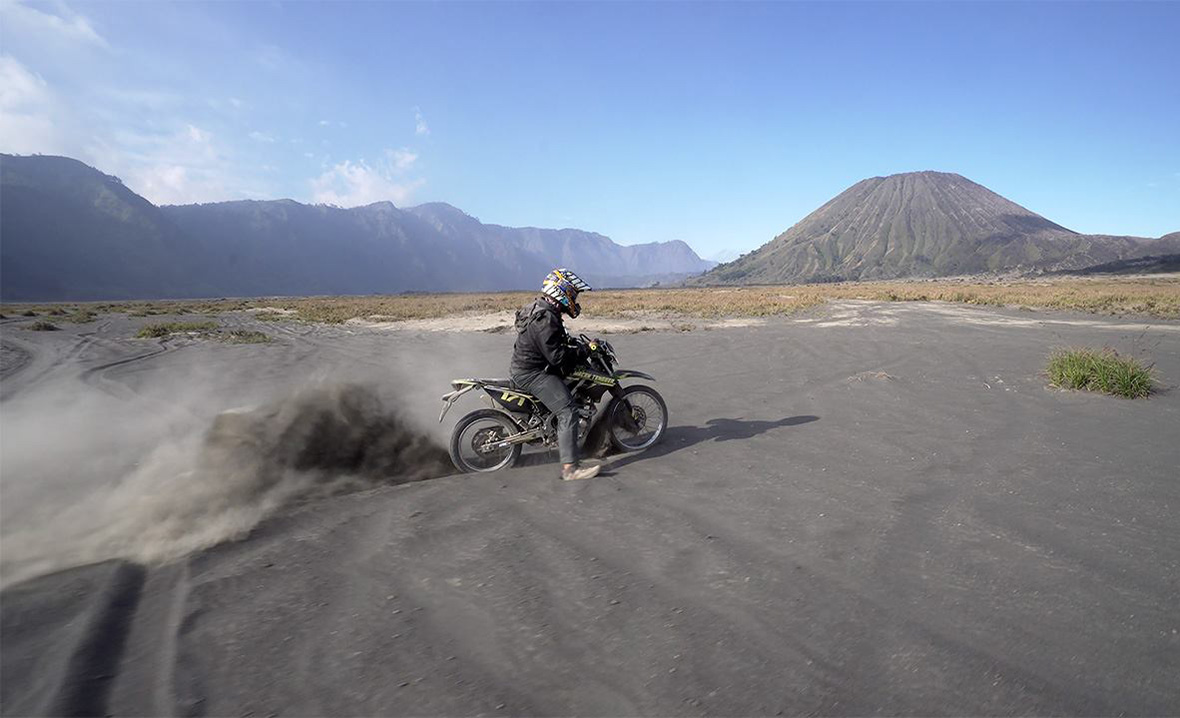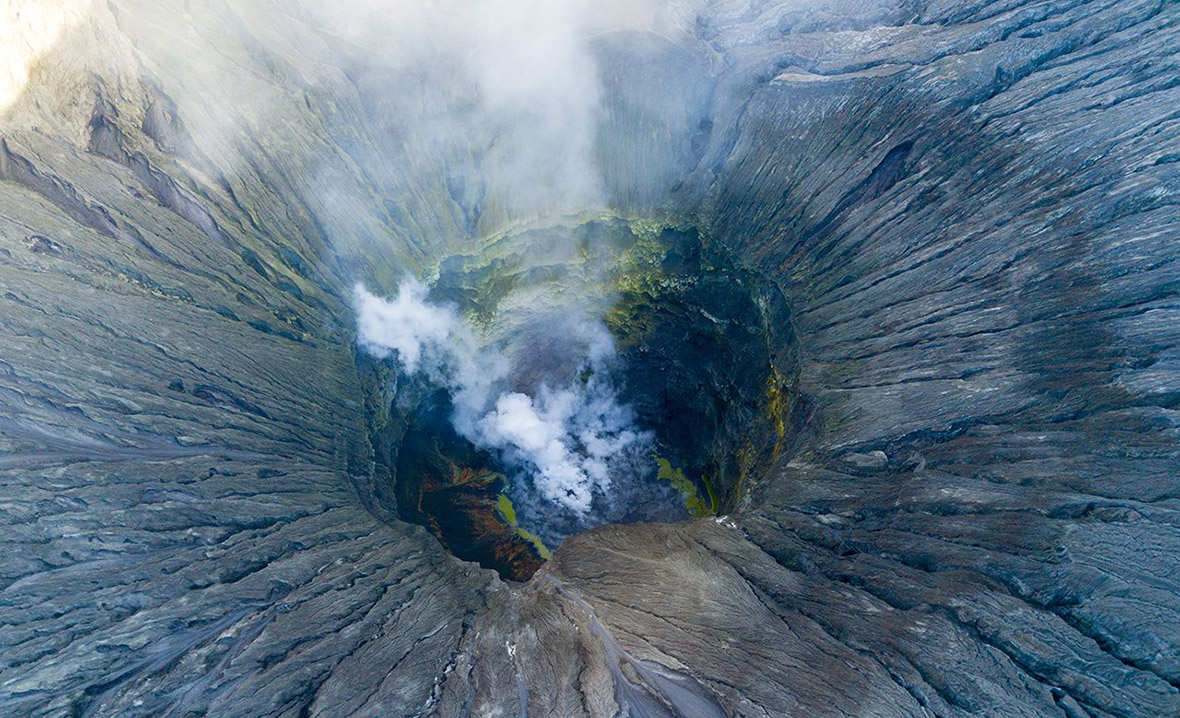WRITTEN BY
Jay Tindall
PUBLISHED ON
January 29, 2018
LOCATION
Indonesia
Istood on a yard-wide path as the ground shook beneath me – on one side, a craggy cliff, on the other a caldera burning with smoke and ash – as I tried to control the drone. The thought crossed my mind that I could have – should have – just filmed all this before climbing to the volcano’s edge.
Seas of ash, a precipitous caldera, and views of the tallest mountain in Java – Bromo is perhaps the most famous active volcano in Java. However, with insider access to lesser-known locations and proper timing, Gunung Bromo can be experienced in peace.
Bromo
The first question most have about visiting a volcano is, “Does it erupt?” In Bromo’s case, the answer is yes, most recently in 2015. The dramatic eruption in 2011 shot ash 18,000 feet into the air. These thoughts are never far from the mind when one feels the vibrations underfoot throughout climbing the ridge.
Arriving at Surabaya and then Malang, my party woke early in the morning for the three-hour drive to Bromo, with little along with way of interest but a waterfall. But, the lush greenery of Java soon starts to fall away; we had entered the Tengger Semeru National Park. Trees are replaced by dust and ash – more like a torched lunar landscape than the jungles of Java.

ABOVE: The FJ40 Toyota Land Cruiser, a tough vehicle for this rugged, arid landscape.
We drove through this strange landscape in an FJ40 Toyota Land Cruiser, one of the few types of vehicles found nearby and a hearty vehicle to be sure with a 1960s design to it. But, even these tough vehicles have trouble with the sand sea. Cars will only take you so far on your way to Bromo, and they end at a tract known as the Tengger Sand Sea. From here, travelers will need to board a motorbike or a horse to get them over the fine ash and sand.

ABOVE: Horses and motorbikes are the best way to traverse the sand sea before reaching Bromo.
The admiration for the mountain stretches here into the Pura Luhur Poten, a Hindu temple at the foot of the volcano – standing strong against the evacuations and warnings that come with life near the lip of a volcano. Bromo – a Javanese pronunciation of the Hindu creator god, Brahma – is a very spiritual place, sometimes disturbingly so.

ABOVE: Hindu Temple at the foot of the Bromo.
At the annual Yadnya Kasada Festival (or Kesodo), worshippers come with chickens and other livestock and chuck them into the volcano, others throwing gifts and money as some climb down into the upper reaches of the caldera to catch the offerings. The festival emanates from a legend that a couple were granted 24 children on the condition that they throw the 25th into the volcano as a sacrifice. The festival is held on the 14th day of the Kasada calendar month of the Hindu lunar calendar.

ABOVE: Bromo’s smoldering caldera.
Most who venture to Bromo do so in the morning for the sunrise, the area packed with eager photographers. Arriving in the afternoon after our drive, we were determined to catch the sun on its way down. We walked up the volcano after visiting the temple in what turned out to be a steep climb.
Stairs lead to the rim, where there is, thankfully a guardrail. That minor safety net disappears as one rounds the caldera, which is permitted to go about a quarter of the circumference. Only a few yards wide, it was slightly terrifying to walk on, let alone fly a drone.

If it came to falling, my preference would be down the mountain craters as opposed to the precipitous, sheer drop into ash and lava. One of the most striking scenes at Bromo is the caldera. Unlike the colorful hell of Ijen or the cartoon puffing of nearby Semeru, Bromo’s steep caldera looks like an angry punch into the planet, a magma chamber that goes down an estimated six kilometers.
With the drone in the air and my feet on perpetually and literally shaky ground, I will admit to getting a little vertigo on the rim. Shooting in the middle of the day is not recommended as the lighting is quite harsh, and the sunset climb proved worth it. We were able to see fog falling over the edge of Tengger, like it was falling into a great, planetary soup bowl; our guide was sure to impress upon me the rarity of such a sight.

ABOVE: The rare sight of fog rolling into the volcanic area surrounding Bromo.
We descended from the volcano in darkness and rode horses over the sand sea back to our hotel.
The next morning we woke early – very early – to see Bromo from a distance. It should be noted that there are two view points for catching Bromo at sunrise, usually swarmed with people trying to get a gorgeous photo of how peaceful everything looks as they clamber over one another. We had a secret spot, only accessible by taking motorbikes through the early-morning dark. It’s surprisingly cold and exactly as dangerous as it sounds, complete with trees smacking us in the face.

ABOVE: Bromo and Semeru in a single shot from a little-known viewing area.
It was, however, worth it: Bromo, Semeru, and Batok, all in one shot and slathered in early morning light.
Timed correctly, even the normally crowded viewpoints can make for pleasant and peaceful viewing. Considering Bromo is one of the most visited sites in all of Java, experiencing the volcano is all about the timing. We stayed in the area for the day, filming, for one last day of the sun setting on Bromo. From far away, volcano looks lovely – positively pastoral – but at the rim, staring into the crater, it’s more imposing than idyllic.

ABOVE: Bromo from above.
It’s strange to think of this land of lava, smoke, and ash as a haven, but it’s said that the Tenggerese fled to this area after the fall of the Majapahit Empire, bringing with them their traditions and beliefs. It is a strange, brave soul that is comforted by a breathing mountain, and while the gods and legends may seem, to me, fantasies, there is no denying that there is a little magic in Bromo.




